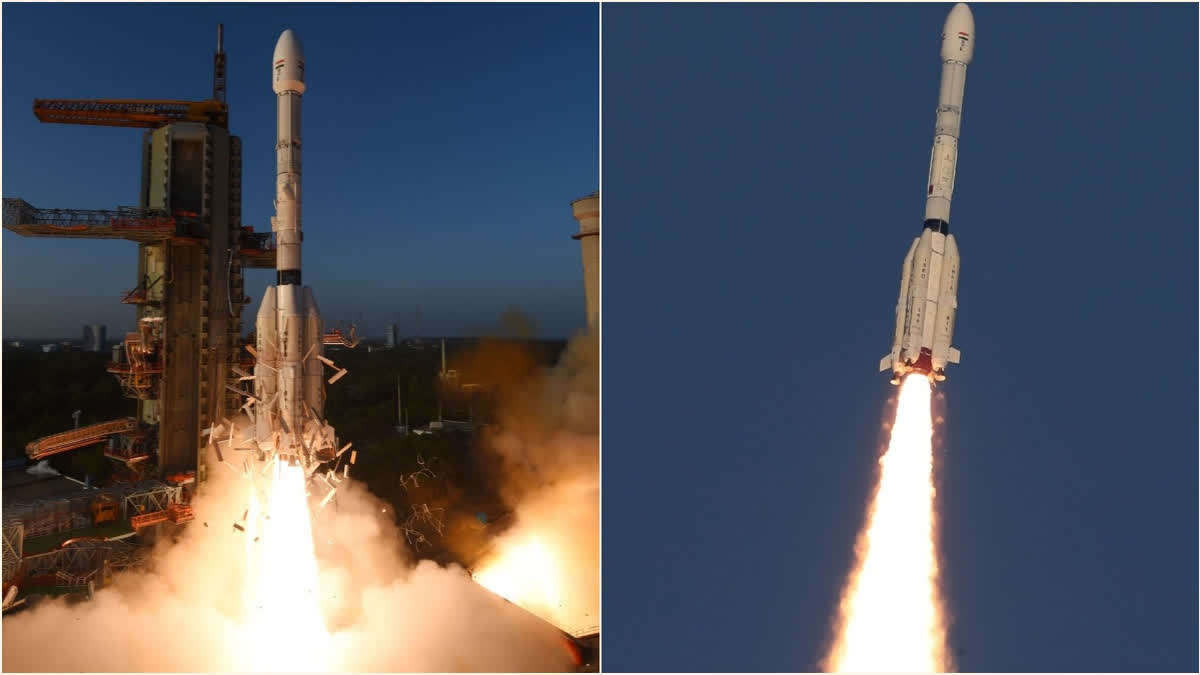Sriharikota (Andhra Pradesh): The Indian Space Research Organisation has launched the INSAT-3DS meteorological satellite on board a Geosynchronous Launch Vehicle (GSLV) rocket. The Indian Space Research Organisation launched the satellite at 5.35 pm on Saturday from the Sriharikota spaceport.
INSAT-3DS satellite aims to augment the study of the Earth's surface and oceanic observations. The 51.7 metre tall GSLV-F14 soared majestically from the second launch pad at the spaceport here, leaving behind thick fumes on its tail and soaring towards the sky. It saw thunderous applause from spectators who had gathered at the gallery here since afternoon.
The flawless mission prompted the ISRO to virtually heave a sigh of relief over the challenging GSLV rocket technology, as the director of Saturday's mission said the "naughty boy has matured into an obedient, disciplined boy," apparently referring to its past unsuccessful missions.
ISRO Chairman S Somanath said the success gave the space agency "greater confidence," as the GSLV will be next deployed in the NISAR mission, a collaborative effort with the US' NASA. The INSAT-3DS satellite, weighing 2274 kg is a follow-on mission of the third generation meteorological satellite to be placed in a geostationary orbit and is funded by the Ministry of Earth Sciences.
The satellite would serve various departments under the Ministry of Earth Sciences including the Indian Meteorological Department (IMD), ISRO said. This is the second mission for ISRO in 2024 after the successful launch of PSLV-C58/EXPOSAT mission on January 1.
The objective of the mission is to provide continuity of services to the existing operational INSAT-3D and INSAT-3DR for enhanced meteorological observations, monitoring of land and ocean surfaces for weather forecasting and disaster warning as well as provide Satellite Aided Research and Rescue Services.
ISRO Chairman S Somanath on Saturday visited Sri Chengalamma Parameshwari temple in Nellore district ahead of the launch of the INSAT-3DS satellite and prayed for its success. Somanath visited the temple at Sullurpeta this morning, along with a couple of other officials to participate in a short ritual and also offered flowers to the deity. "I came here today to seek the blessings of Chengalamma Bhagavati for blessing us for the success of this mission," Somnath said.
The ISRO said that the GSLV, in its 16th mission, aims to deploy the INSAT-3DS meteorological satellite into the Geosynchronous Transfer Orbit (GTO). Subsequent orbit-raising manoeuvres will ensure that the satellite is positioned in a geostationary orbit. INSAT-3DS satellite is a follow-on mission of third third-generation meteorological satellite from geostationary orbit.
Why is GSLV F14 called 'Naughty Boy'?
The GSLV F14 spacecraft that took off on the 16th mission to launch the INSAT-3DS meteorological satellite has been called the ‘Naughty Boy’ of India’s space programme by a former chairman of the Indian Space Research Organisation (ISRO) because the spacecraft has faced several failures in the past, with a failure rate of over 40 per cent.
Of its total of 15 space missions so far, the GSLV has faced failures in six missions. Its last mission in May 2023 was successful, but the previous mission had failed. The three-stage rocket, with a cryogenic upper stage, after a flight of about 20 minutes, is expected to separate the satellite Indian National Satellite System (INSAT) weighing 2,274 kgs from the GSLV rocket, to be placed into the Geosynchronous Transfer Orbit.
According to the space agency, the 51.7 metres tall rocket, carries imager payloads, sounder payloads, data relay transponders, satellite aided search and rescue transponders to study the cloud properties, fog, rainfall, snow cover, snow depth, fire, smoke, land and ocean.
Various departments of the Ministry of Earth Sciences (MoES) such as the India Meteorology Department (IMD), National Centre for Medium-Range Weather Forecasting (NCMRWF), Indian Institute of Tropical Meteorology (IITM), National Institute of Ocean Technology (NIOT), Indian National Center for Ocean Information Services (INCOIS) and various other agencies and institutes will be using the INSAT-3DS Satellite data to provide improved weather forecasts and meteorological services.
- " class="align-text-top noRightClick twitterSection" data="">
Read More



